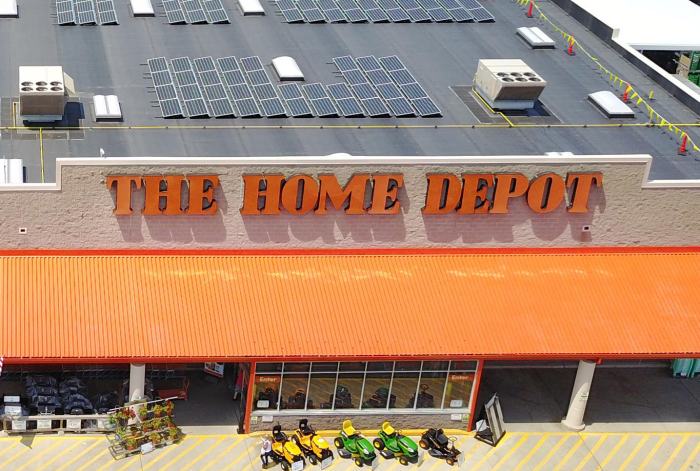The world’s largest home improvements retailer is installing solar panels on 50 more of its stores, along with Tesla Powerpack battery storage at some outlets.
The Home Depot is the USA’s version of Bunnings, but on a much larger scale. It has 2,282 retail stores across North America, Mexico, Guam, Puerto Rico and the U.S. Virgin Islands, and employs more than 400,000 people. During its 2016 financial year, the company racked up sales of USD $94.6 billion and earnings of $8.0 billion .
All those outlets consume a lot of electricity and solar power is playing an increasing role in helping meet The Home Depot’s energy needs.
The company says the 1,000 solar panels installed on each store will slash mains grid electricity demand of each participating outlet by an estimated 30 to 35 percent annually.
Six of twenty-two stores in California and New York to have solar power systems installed will also utilize Tesla Powerpacks for energy storage.
“Our alternative energy projects are important elements of our sustainability and operations efforts as they reduce carbon emissions while also lowering our energy costs,” said David Hawkins, The Home Depot’s vice president of labor and operations.
Among its other renewable energy projects are solar Power Purchase Agreements (PPAs) in Delaware and Massachusetts. The company is also purchasing power from the Los Mirasoles Wind Farm in Texas and the Zopiloapan Wind Farm in central Mexico.
The company’s 2016 Corporate Responsibility Report states that through various initiatives, The Home Depot had reduced its carbon emissions from 7 million to 4.5 million tonnes over the previous 6 years – a 35% decrease. In the past 3 years, it has decreased electricity consumption by 18%.
The company has set a goal of 135 megawatts of alternative and renewable energy by 2020; enough to power 250 of its stores.
Bunnings’ Solar Energy Efforts
So, what’s Australia’s Home Depot, Bunnings, up to on the solar power front?
Bunnings has 249 warehouses, 77 smaller format outlets, 33 trade centres and three frame and truss facilities operating across Australia and New Zealand. Collectively, that’s a lot of valuable rooftop real estate that could be potentially hosting solar panels to harvest the energy of the sun.
Bunnings says more than 85 per cent of its greenhouse gas emissions are associated with the electricity used to power its stores and it is trialing micro-renewable power generation at a small number of outlets..
The Bunnings 2017 Community Report Card states it has installed 14 solar PV systems across the Bunnings network to date, which are generating between 10 per cent and 20 per cent of each store’s daily energy requirements.


 RSS - Posts
RSS - Posts



Speak Your Mind